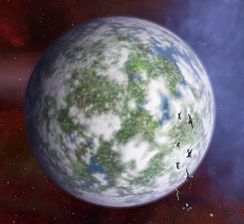Difference between revisions of "Planet Carlisle"
(replaced: {{Version|4.85.3}} → {{Version|4.85.2}}) |
(v4.88) |
||
| Line 1: | Line 1: | ||
| − | {{Version|4. | + | {{Version|4.88.0.0}} |
{{Planet Infobox | {{Planet Infobox | ||
| name = Planet Carlisle | | name = Planet Carlisle | ||
| image = Carlisle.jpg | | image = Carlisle.jpg | ||
| − | | owner = | + | | owner = |
| system = [[Newcastle]] | | system = [[Newcastle]] | ||
| − | | sector = | + | | sector = 4C |
| house = {{House Link | Bretonia}} | | house = {{House Link | Bretonia}} | ||
| − | | population = | + | | population = |
| docking = No | | docking = No | ||
| terrain = Terrestrial | | terrain = Terrestrial | ||
| diameter = 12,642 km | | diameter = 12,642 km | ||
| mass = 6,11 x 10e24 kg | | mass = 6,11 x 10e24 kg | ||
| − | | temperature = - | + | | temperature = -8ýC to 53ýC |
| escape_velocity = 11.15 km/sec | | escape_velocity = 11.15 km/sec | ||
}} | }} | ||
>>><span style="color:red">RESTRICTED</span><<< | >>><span style="color:red">RESTRICTED</span><<< | ||
| − | + | ||
| − | From orbit, planet Carlisle looks invitingly hospitable with deep oceans and vast continents, but in reality it is a tropical nightmare. Temperatures at the equator never drop below | + | From orbit, planet Carlisle looks invitingly hospitable with deep oceans and vast continents, but in reality it is a tropical nightmare. Temperatures at the equator never drop below 60 Celsius. The oceans, however, remain a pleasant 26C in temperature, even quite far to the north and south. The lush greenery seen from orbit turns into dense, humid jungles and rain forest upon closer inspection, and there are several native creatures that consider humans to be good eating. The planet has significant deposits of aluminium, titanium and [[gold]], and radium has been detected, although no mining operations have as yet been established planet-side. |
| − | planet-side. | + | |
| − | + | For many years, scientists from [[Cambridge]] have been studying a particularly virulent form of bacteria native to the planet that has proven to successfully infect and kill humans. The bacterium quickly spreads throughout the body and dissolves every internal organ within a matter of hours. This has of course prevented the colonization of the planet, although [[Cryer]] [[Scientists|researchers]] onboard [[Cambridge Research Station]] say they have created a protein that will target and eliminate the bacterium planet-wide, thus hopefully paving the way for Carlisle's colonization within the near future. | |
| − | For many years, scientists from [[ | ||
| − | |||
Revision as of 19:37, 26 April 2015
This article has not been verified to be up to date for the latest version of the Discovery mod. The last edit was made on 26.04.2015 (DD/MM/YYYY). You may help by updating it, often by using the code generator.
| Planet Carlisle | |
| Location | 4C, Newcastle |
| Technical information | |
| Docking | No |
| Terrain | Terrestrial |
| Diameter | 12,642 km |
| Mass | 6,11 x 10e24 kg |
| Temperature | -8ýC to 53ýC |
| Escape velocity | 11.15 km/sec |
>>>RESTRICTED<<<
From orbit, planet Carlisle looks invitingly hospitable with deep oceans and vast continents, but in reality it is a tropical nightmare. Temperatures at the equator never drop below 60 Celsius. The oceans, however, remain a pleasant 26C in temperature, even quite far to the north and south. The lush greenery seen from orbit turns into dense, humid jungles and rain forest upon closer inspection, and there are several native creatures that consider humans to be good eating. The planet has significant deposits of aluminium, titanium and gold, and radium has been detected, although no mining operations have as yet been established planet-side.
For many years, scientists from Cambridge have been studying a particularly virulent form of bacteria native to the planet that has proven to successfully infect and kill humans. The bacterium quickly spreads throughout the body and dissolves every internal organ within a matter of hours. This has of course prevented the colonization of the planet, although Cryer researchers onboard Cambridge Research Station say they have created a protein that will target and eliminate the bacterium planet-wide, thus hopefully paving the way for Carlisle's colonization within the near future.
